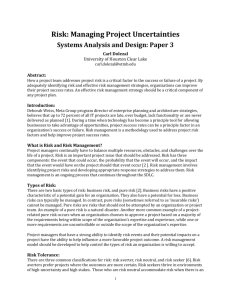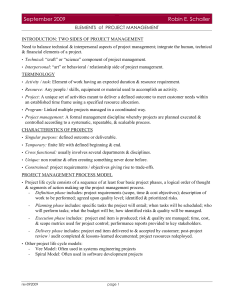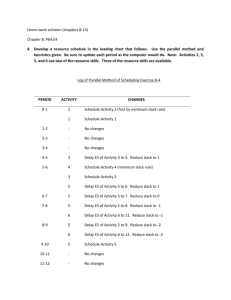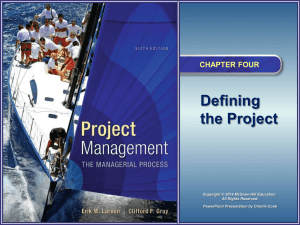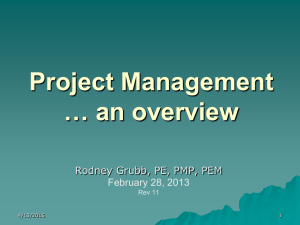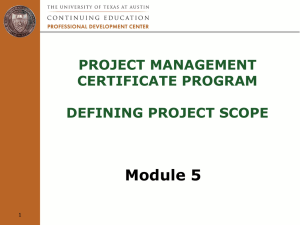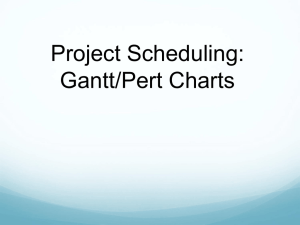Project Management for Maximum Effectiveness
advertisement
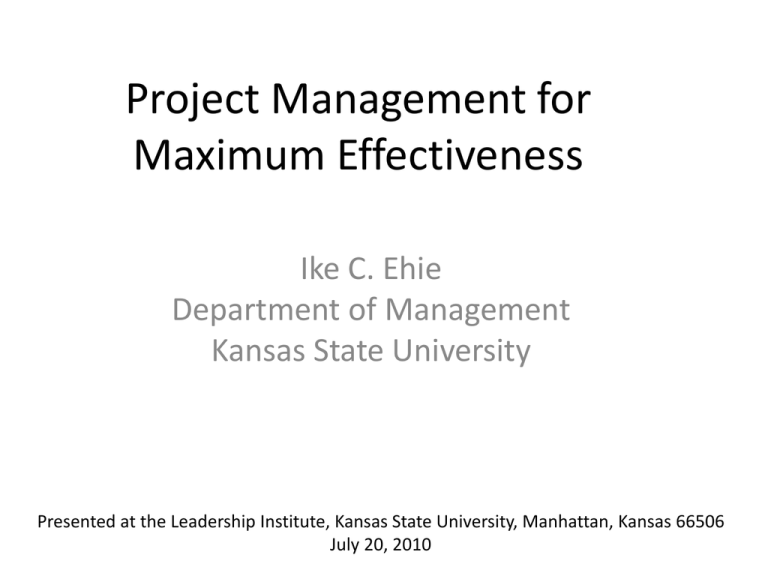
Project Management for Maximum Effectiveness Ike C. Ehie Department of Management Kansas State University Presented at the Leadership Institute, Kansas State University, Manhattan, Kansas 66506 July 20, 2010 Agenda • • • • • What is a project What is project management Project scope statement Effective tools for managing a project Project planning and schedule –The Albion Sugar Company • Project management in public sector • Conclusion Project Definition • A Project is a temporary endeavor undertaken to create a unique product or service. – Temporary – Unique “Projects, rather than repetitive tasks, are now the basis for most valueadded in business” -Tom Peters Project characteristics • Endeavors of any size may be a project – Large and small projects demand different handling • Temporary – Distinguishes project from process • Unique – Not the same old thing Project Management • Management of the work involved in a project in terms of: – Competing demands for scope, time, cost, risk, and quality – Stakeholders with different needs and expectations – Identified requirements Project Management Triple Constraints FIGURE 4.1 Quadruple Constraints of Project Success Client Budget Acceptance Success Schedule Performance Project Scope Statement • Project Scope – A definition of the end result or mission of the project—a product or service for the client/customer—in specific, tangible, and measurable terms. Also called a statement of work (SOW) • Purpose of the Scope Statement – To clearly define the deliverable(s) for the end user. – To focus the project on successful completion of its goals. – To be used by the project owner and participants as a planning tool and for measuring project success. Project Scope Checklist 1. Objective/s – answers the questions of what, when, and how much 2. Deliverables – the expected outcomes/outputs over the life of the project 3. Milestones- a significant event in a project that occurs at a point in time 4. Technical requirements - project specifications needed to meet a specified performance 5. Limits and exclusions – defines the boundary of the project by stating what is not included Exercise #1 • Describe a project that you have been involved with in the past one year • Define the project scope statement – Objective/s, deliverables, milestone, requirements & restrictions • Discuss this with your partner Exercise #2 • Think of the project you will undertake in the next year • Define the project scope statement • Discuss your project scope statement with your partner Why are Projects Important? 1. Budgeting 2. Staff allocation 3. Schedule development 4. Schedule credibility 5. Sanity retention 6. Increasingly complex and technical products 7. Emergence of global markets Project Life Cycles Man Hours Conceptualization Planning Execution Termination Fig 1.3 Project Life Cycle Stages Project Life Cycles • Conceptualization - the development of the initial goal and technical specifications. • Planning – all detailed specifications, schedules, schematics, and plans are developed • Execution – the actual “work” of the project is performed • Termination – project is transferred to the customer, resources reassigned, project is closed out. Project Life Cycles and Their Effects Client Interest Project Stake Resources Creativity Uncertainty Conceptualization Planning Execution Termination Fig 1.4 Effective Project Management Tools • Work Breakdown Structure (WBS) – An hierarchical outline (map) that identifies the products and work elements involved in a project – Defines the relationship of the final deliverable (the project) to its subdeliverables, and in turn, their relationships to work packages – Best suited for design and build projects that have tangible outcomes rather than process-oriented projects How WBS Helps the Project Manager • WBS – Facilitates evaluation of cost, time, and technical performance of the organization on a project – Provides management with information appropriate to each organizational level – Helps in the development of the organization breakdown structure (OBS), which assigns project responsibilities to organizational units and individuals – Helps manage plan, schedule, and budget – Defines communication channels and assists in coordinating the various project elements Work Breakdown Structure FIGURE 4.4 WBS Coding Work Packages • A Work Package Is the Lowest Level of the WBS. – It is output-oriented in that it: • Defines work (what) • Identifies time to complete a work package (how long) • Identifies a time-phased budget to complete a work package (cost) • Identifies resources needed to complete a work package (how much) • Identifies a single person responsible for units of work (who) Effective Project Management Tools • Responsibility Matrix (RM) – Also called a linear responsibility chart – Summarizes the tasks to be accomplished and who is responsible for what on the project • Lists project activities and participants • Clarifies critical interfaces between units and individuals that need coordination • Provide an means for all participants to view their responsibilities and agree on their assignments • Clarifies the extent or type of authority that can be exercised by each participant Responsibility Matrix for a Market Research Project FIGURE 4.7 Responsibility Matrix for the Conveyor Belt Project FIGURE 4.8 Effective Project Management Tools • Project Communication Plan – What information needs to be collected? – Who will receive information? – What information methods will be used? – What are the access restrictions? – When will information be communicated? – How will information be communicated? Communication Plan: FIGURE 4.9 Effective Project Management Tool Gantt Chart FIGURE A8.2B Effective Project Management Tools • The Project Network – A flow chart that graphically depicts the sequence, interdependencies, and start and finish times of the project job plan of activities that is the critical path through the network • Provides the basis for scheduling labor and equipment • Provides an estimate of the project’s duration • Provides a basis for budgeting cash flow • Highlights activities that are “critical” and should not be delayed • Help managers get and stay on plan Basic Rules to Follow in Developing Project Networks • Networks typically flow from left to right. • An activity cannot begin until all of its activities are complete. • Arrows indicate precedence and flow and can cross over each other. • Identify each activity with a unique number; this number must be greater than its predecessors. • Looping is not allowed. • Conditional statements are not allowed. • Use common start and stop nodes. Koll Business Center—Complete Network FIGURE 6.4 Determining Slack (or Float) • The critical path is the network path(s) that has (have) the least slack in common. • The critical path is the longest path and determines the completion of the project • Free Slack (or Float) – The amount of time an activity can be delayed without delaying connected successor activities • Total Slack – The amount of time an activity can be delayed without delaying the entire project Sensitivity of a Network • The likelihood the original critical path(s) will change once the project is initiated. – Function of: • The number of critical paths • The amount of slack across near critical activities Rationale for Reducing Project Duration • Time Is Money: Cost-Time Tradeoffs – Reducing the time of a critical activity usually incurs additional direct costs. • Cost-time solutions focus on reducing (crashing) activities on the critical path to shorten overall duration of the project. – Reasons for imposed project duration dates: • Customer requirements and contract commitments • Time-to-market pressures • Incentive contracts (bonuses for early completion) • Unforeseen delays • Overhead and goodwill costs • Pressure to move resources to other projects Managing Public Sector Projects • Operating under overlapping and often conflicting set of rules and procedures • Rules are in place to ensure consistent standard of behaviors and a project must adhere to those rules • The political process inherently hands you a built-in adversity; other parties may not necessarily be interested in the success of the project • More stakeholders to please with less authority • May not have full control of the budget • Project scope can change with little or no notice Skills Needed for Managing Public Project • Softer or people skills – – – – – Conflict management Negotiation Diplomacy Managing stakeholders expectations Emotional maturity With less authority, the key is to induce behaviors rather than order it


